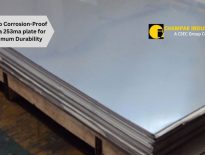High-tensile plates are strong and durable materials widely used in the construction and industrial sectors. They are meant to withstand high stress, pressure, and rigidity, making them ideal for heavy-duty applications. However, installing and maintaining high-tensile plates requires expertise, caution, and proper safety measures to prevent accidents, damage, or failure. In this blog post, we will guide you on installing and maintaining high-tensile plates, highlighting the best practices and safety tips to follow. Whether you are a professional contractor, engineer, or DIY enthusiast, this guide will help you to maximize the quality, longevity, and performance of high-tensile plates in diverse settings.
Factors To Consider
Understand the Properties and Characteristics of High-tensile plates.
Before installing high-tensile plates, you must familiarize yourself with the technical aspects, including the material grade, thickness, dimensions, and strength factors. High tensile plates come in different types, such as carbon steel, alloy steel, stainless steel, and aluminium, each with unique properties and characteristics that can affect their performance. You should also consider the specific environment and conditions where the high-tensile plates will be installed, such as temperature, humidity, corrosion, and impact resistance.
Use proper tools, equipment, and techniques.
You need to use the right tools, equipment, and techniques to ensure a smooth and safe installation of high-tensile plates. Some tools you will need to install high-tensile plates include a saw, drill, hammer, screws, nuts, bolts, and clamps. You should also wear the appropriate personal protective equipment, such as gloves, safety glasses, and hard hats, to protect yourself from potential hazards during installation. Additionally, you should follow the manufacturer’s instructions and industry best practices to ensure that the plates are installed accurately, securely, and in accordance with the relevant standards.
Inspect and maintain high-tensile plates regularly.
Once you have installed high-tensile plates, you should schedule regular inspections and maintenance to ensure they are in good working condition and free from defects, wear, or damage. Regular inspections can help detect any signs of corrosion, rust, cracks, or deformation affecting the plates’ structural integrity and performance. You should also regularly clean and lubricate the plates to prevent dirt buildup, friction, and other forms of wear that can reduce lifespan.
Monitor and respond to changes in performance.
Another critical aspect of maintaining high-tensile plates is to monitor their performance regularly and respond promptly to any changes or anomalies. You should track the plates’ performance metrics, such as stress, strain, deflection, and load capacity, and compare them against the acceptable thresholds and standards. If you notice any deviations or unusual patterns, you should investigate the root causes and take appropriate remedial actions, such as repair, replacement, or reinforcement.
Conclusion:
Installing and maintaining high-tensile plates requires technical expertise, proper equipment, and safety awareness. By following the best practices and safety tips outlined in this blog post, you can ensure that your high-tensile plates are installed accurately, securely, and safely and remain in good working condition throughout their lifespan. However, if you encounter any challenges or uncertainties during installation or maintenance, please seek the assistance of a qualified professional or contact the manufacturer or supplier for more information.







